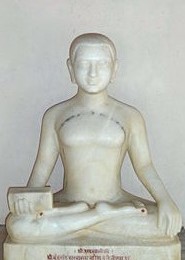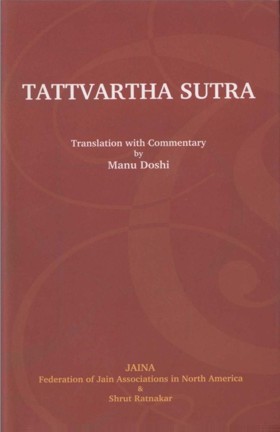08.12 Gatijātisharirāngopāngnirmānbandhansanghātsansthānsanhanansparsharasgandhvarnānupoorvyagurulaghoopaghātparāghātātapodyotochchhvāsvihāyogatayah Pratyeksharirtrassubhagsuswarshubhsookshmaparyāptasthirādeyayashānsi Setarāni Tirthakruttvam Cha
Audio: Sanskrit: गतिजातिशरीराङ्गोपांगनिर्माणबंधनसंघातसंस्थानसंहननस्पर्शरसगंधवर्णानुपूर्व्यगुरूलघुपघातपराघातापोद्द्योतोच्छ्वासविहायोगतयःप्रत्येकशरीरत्रससुभगसुस्वरशुभसूक्ष्मपर्याप्तस्थिरादेययशांसि सेतराणि तीर्थकृत्वं च्।
Hindi: गति, जाति, शरीर, अंगोपांग, निर्माण, बंध, संघात, संस्थान, संहनन, स्पर्श, रस, गंध, वर्ण, आनुपूर्वी, अगुरुलघु, उपघात, पराघात, आतप,उद्योत, उच्छवास,विहायोगति, तथा प्रत्येक शरीर और साधारण शरीर, त्रस और स्थावर,सुभग और दुर्भग, सुस्वर और दुःस्वर,शुभ और अशुभ, सूक्ष्म और बादर, पर्याप्त और अपर्याप्त,स्थिर और अस्थिर, आदेय और आनादेय, यशकीर्ति और अपयश कीर्ति और तीर्थंकर नाम कर्म ये 42 उत्तर प्रकृतियाँ नाम कर्म की होती है।
08.12
English: Nam Karma consists of 42 categories, viz. states of existence, species, body, limbs and organs, formation, cohesion, integration, configuration, bone-joints, touch, taste, odor, complexion, balancing, vulnerability, bellicosity, heat, luster, respiration, linear or non-linear propulsion, individual or common body, mobility or immobility, pleasing or ugly appearance, sweet or harsh voice, wholesome or unwholesome body, subtlety or grossness, completely or incompletely constituted body, stability or instability, respectability or non-respectability, reputability or non-reputability and omniscience.
Nam Karma is of many types. It is variously specified of 42, 65, 93 and 103 categories depending upon the nature of classification. This sutra specifies 42 categories. All of them relate to different aspects of body, its state of existence etc. There are mainly four states of existence, viz. heavenly, human, sub-human (animals, plant life, micro-organism etc.) and infernal. There are five main types of species, viz. one-sensed, two-sensed, three-sensed, four-sensed and five-sensed, Bodies are of five types, viz. gross, protean, carrier, lustrous and Kārman. There are varieties of limbs and organs in a body depending upon its anatomy.
Formation relates to the sexual symbol etc. Cohesion relates to holding together of different organs. Configuration relates to the arrangements of different parts. Bone joints relate to the strength of body. There are six types of such joints, a) interlocking of bones on both sides and reinforced by a plate, b) interlocking on one side and reinforced by a pin, c) interlocking on both sides without reinforcement, d) interlocking on one side and reinforced by a pin, e) pinning of bones and 0 bones bound by skin, sinews etc.
There are eight kinds of touch, five kinds of taste, two kinds of odor and five kinds of complexion. Balancing relates to the body being neither too heavy nor too light. Vulnerability and bellicosity relate to the striking and counterstriking capability. Heat, luster and respiration are self-explanatory. Linear or non-linear propulsion relates to the flight of soul while migrating from one body to another. If there is one soul in a body, it is termed as individual body; having multiple souls in a body is termed as common body. The rest of the terms are self-explanatory.
 Acharya Umaswati
Acharya Umaswati
